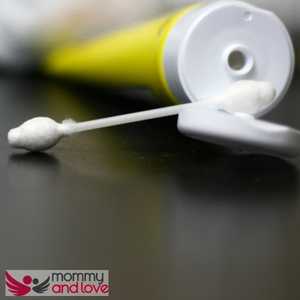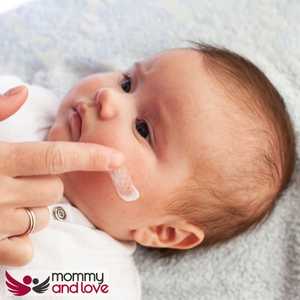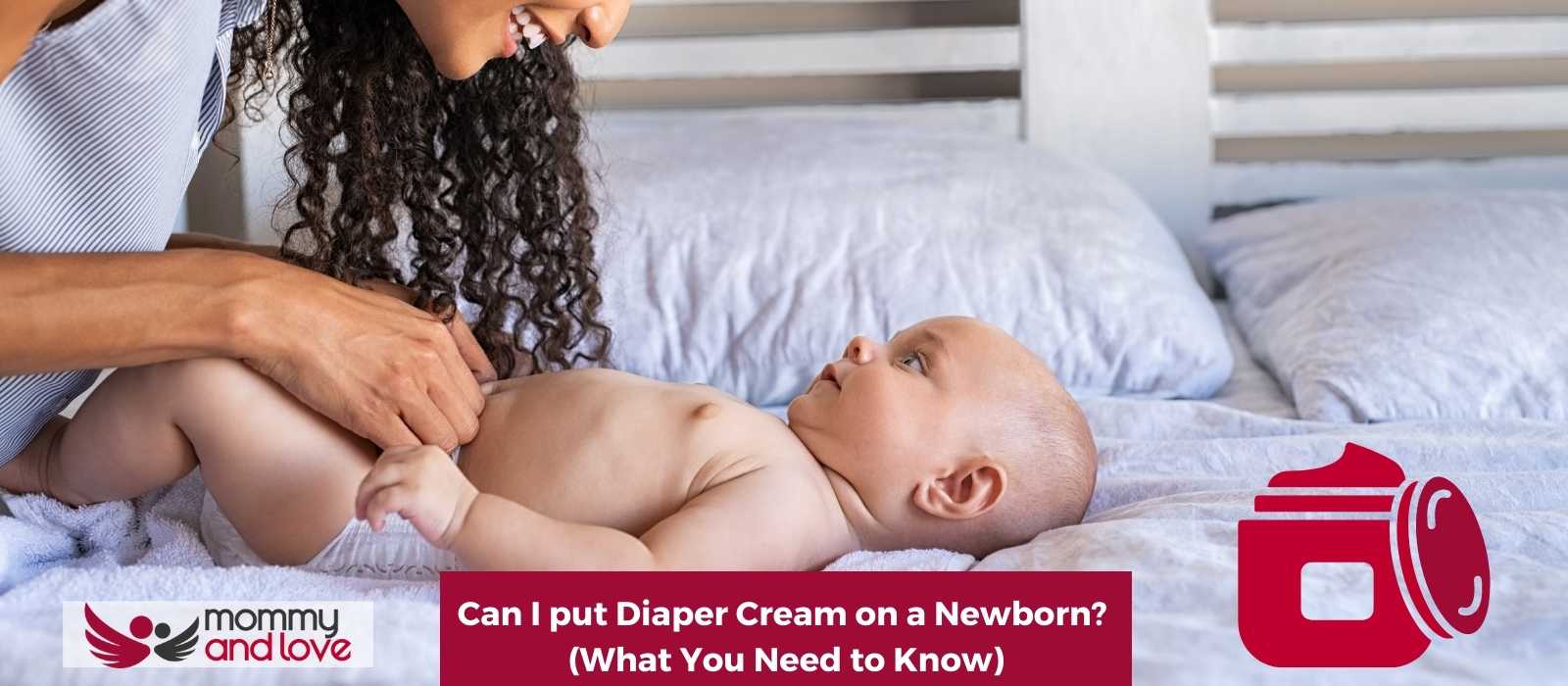Like any good blog, our answer is… that depends…
It depends on whether your newborn needs diaper cream, what type of diaper cream you are planning on using and if there are any known allergies in your family history.
In general, diaper cream is used to help protect your baby’s skin from irritation caused by a yeast or bacterial infection. Diaper rash usually occurs due to prolonged contact with urine and feces as well as poor air circulation, which can lead to the growth of bacteria. This condition normally starts on the inner-thighs and quickly spreads over the lower abdomen and genital area.
However, not all diaper creams are equal and some have some very dubious ingredients! This article is part of our series of natural treatments for a baby’s diaper rashes.
What Does Diaper Rash Cream Do?

Diaper cream is supposed to help protect your baby’s skin by creating a thick barrier to prevent the moisture from getting through.
It also gives you that added benefit of treating any existing diaper rash, preventing it in the first place and moisturizing their skin.
Diaper creams also contain ingredients such as zinc oxide which sits on top of the skin and prevents moisture from evaporating away. It also helps to reduce skin irritation and dryness.
Diaper rash products are either for healing diaper rash or for preventing diaper rash (a barrier). Those which are for preventing mean applying a thick layer (usually containing petroleum jelly) as a protective when you change diapers.
Is Diaper Rash Cream necessary?
No, diaper cream is not necessary. In fact, the American Academy of Pediatrics said in a research article that “most cases of diaper rash can be prevented with good hygiene practices.” That means frequent diaper changes, keeping the area dry and clean and using a mild soap (fragrance-free soap is best) in the diaper area.
If your baby’s diaper rash is caused by an irritant, it’s much better to remove the irritant from the baby’s environment than apply diaper cream which includes toxins and parabens that you don’t know what the long term effects of are.
If your child has a rash, then before the age of 6 months treating diaper rash can usually be dealt with by just changing diapers more frequently and ensuring the dirty diaper is taken off immediately. If your baby has sensitive skin ensure you are only using natural ingredients on it. This includes stuff in your baby wipes or baby powder. (We’ve done a full guide to baby powder and diaper rash).
Does Your Newborn Need Diaper Cream?

A newborn baby has very sensitive, ‘thin’ skin. The skin pores are open and the area is still very moist.
Whilst it might be a very natural reaction to protect this delicate skin, actually, your newborn baby probably doesn’t need any diaper cream.
It’s unlikely that they have a diaper rash at this stage (these normally start when they start solid foods) and your baby’s skin isn’t at risk of cracking.
At this stage, depending on the diaper cream you are using, they could actually cause a rash due to the irritants that may be in them. Irritated skin can be caused by parfum or scents in wipes or baby toiletries used in the bath or for a diaper change. They should not need a protective layer added if you just ensure the diaper region is full clean and wet diapers are changed frequently.
When newborns are first born, doctors recommend just washing them in plain water with no additives. The same goes for changing them at diaper time, less is more. Just a quick wash in warm water should suffice.
We don’t use any commercial baby wipes at all and instead, we just wash our baby’s bottom with water and a cloth or reusable wipes. If we really need to use something then I would rather just use plain warm water as their skin is so delicate at this age any chemicals in the wipes can irritate their skin further.
Unknown Ingredients in Diaper Rash Products
If you have bought a diaper cream to treat diaper rash, then before you use it take a long look at its label.
Firstly always read your diaper cream instructions when it comes to what age it is suitable for. Then read their ingredients. I have a simple rule when it comes to topical treatments for both myself and my children – if I don’t recognise an ingredient I don’t use the product.
If you look at mass-produced diaper rash creams you will see the ingredients often include mineral oil, petroleum, paraffin wax and other ingredients that don’t appear to be ‘natural’. Do you really want these to come into skin contact with your baby’s skin?
We are talking about topical treatments here. This means that they are applied to the skin surface but the skin is the biggest organ in the human body. However, why would you want to put something on your baby’s skin that you wouldn’t eat?
Stop and think, do you really want to put petroleum on your newborn baby?
What about Eczema?

There appear to be many types of eczema, but the most common type is called Atopic Dermatitis which is genetic and can occur in children as young as a few months old.
People who suffer from this condition are more likely to have allergies or asthma, which is why it’s important that they are aware of these allergies in the family history.
If your baby does suffer from eczema then you can use a barrier cream to protect their skin from moisture and infection. Always check with your doctor though before using any type of cream on your baby.
What about Newborn rashes?
There are many causes of rashes in newborns. When it comes to diaper rash then yeast and bacterial infections can cause this but so can heat, cold, sweat and urine as well as other chemicals such as urine-soaked diapers rubbing against the skin. You can also use breastmilk on diaper rashes to help the skin heal.
The majority of diaper rashes occur once your baby has started solid foods. It is true that for exclusively breastfed babies, rashes may occur earlier and is dependent on what food you are eating. We’ve done a series of articles on foods to avoid whilst breastfeeding.
Once your baby starts solids (at about 6-8 months), then diaper rashes usually start. These are a reaction to their immature digestive system dealing with the new foods. At this stage, you can start using diaper creams as their skin is more mature. However, you can help to avoid these diaper rashes by making sure that their diapers are not too tight and that they get a good diet of nutritious foods that don’t irritate the digestive system.
How do I treat mild diaper rash?
Remove wet/soiled diaper ASAP after birth, clean baby with water (breastmilk will work if there is no infection present), pat dry quickly without rubbing. For yeast diaper rashes, you can use plain yogurt on the affected area, don’t wipe it off.
If there is a bacterial infection present then you need to try and clear that up first before using any treatment cream. To be honest I have used breastmilk on my children’s skin for all sorts of skin conditions and it has worked wonders. You can find my favourite breast milk lotion recipe here.
However, if you do want to use a cream then you need to find one that doesn’t contain any ingredients that you don’t want on your child’s skin and is also suitable for their age.
What diaper cream is safe for newborns?
For a baby under two months the answer is none! Diaper creams are not safe for newborns because they contain ingredients that you wouldn’t want to put on yourself or your baby’s skin. I would stick to just natural remedies like breast milk lotion or perhaps some coconut oil as a barrier to prevent diaper rash.
For children over two months, then again, the best diaper creams are the ones that contain only natural ingredients. If your baby has a skin irritation or diaper dermatitis then have a look at our natural remedies for diaper rash and perhaps make yourself a homemade diaper cream just using only natural ingredients. Most diaper rashes, before they start solids, are usually irritant diaper rashes.
If your child has an irritant reaction to diaper rash, you really need to work out what is causing the irritation. This could be scented baby wipes, an allergy to disposable diapers or the detergent used to launder cloth diapers or even just any baby toiletries you have used on them like bubble bath or baby oil.
Should you always use diaper cream?
No. This applies to any baby cream or ointment too, don’t use any creams on your baby unless you really need to.
For instance, if your baby has dry skin and you want to moisturize their skin then just use natural ingredients like coconut oil or cocoa butter and the massage that into the skin.
If your child does have a yeast diaper rash then you can use a thick layer of plain organic yogurt and instead of wiping it off just let it air dry. Yeast rashes could be caused by something you are eating and you may need an antifungal cream to kill the yeast infection and a change of diet if your baby is exclusively breastfed. If using cloth diapers ensure they are thoroughly cleaned and put a paper liner barrier in any fresh diaper used.
If your baby has an irritated rash, don’t put any cream on that area and again just try and figure out what is causing the irritation in the first place. Always give them plenty of diaper-free time and when putting on a clean diaper ensure their skin is dry and clean. Most rashes should clear up with perhaps just a little baking soda bath (baking soda is safe for newborns) or even topical aloe vera gel applied.
Natural Skin Protectants for Diaper Rash
Coconut Oil – Useful for dry skin, dermatitis and yeast infections. Great for use as a barrier cream too to prevent wetness reaching the skin. Great for chapped lips (where you can apply to lips several times throughout day) also. Can also use olive oil for diaper rashes.
Beeswax & Cocoa Butter Combine the two and you have a great barrier that is also easy to rub in and sinks into the skin well. Shea butter is another butter which works on diaper rash.
Lanolin – Lanolin is used in most nipple creams, for new mums that are breastfeeding. However, it is simply the oil stripped from sheep’s wool and then sterilized. It works on the same principle as coconut oil to form a barrier against wetness and irritation on your baby’s bottom
Aloe Vera – a natural gel which proticed skin protection.
If you do use any of these natural products always patch test a small area of your baby’s skin first.
If your baby has contact dermatitis caused by friction or chafing a natural cornstarch powder can do wonders.
Products to Avoid
Here is a list of ingredients that you should avoid using on your child’s skin. These ingredients are also found in adult products so just because it says safe for baby doesn’t mean you should use it on your baby!
Methylisothiazolinone (MI) – This is an anti-bacterial agent which has been linked to causing a severe allergic reaction in children.
Sodium benzoate – This is an ingredient in some diaper creams that have been linked to causing hyperactivity and aggressive behavior in children.
Parabens – These are another group of chemicals that have been linked to causing hormonal imbalances in children, specifically causing breast cancer when used on young boys.
Petroleum by-products – When preservatives like parabens start breaking down they release carcinogenic petroleum by-products into your child’s system.
Take Away On Using Diaper Cream on Newborns
A newborn baby probably doesn’t need any diaper cream and you should avoid using any unnecessary products on their delicate skin. Once they start eating solids diaper rashes might become more prevalent and at this stage, you can look to using diaper creams. But even then consider what’s in the cream, make sure you read the ingredients and are happy for them to go on your precious little one!

This article was written by: Gian MIller – Full-Time Writer, Baby Whisperer & Dad of 3.
Gian spends a lot of his time writing. A self-proclaimed baby whisperer, Gian has been through it all with his own children and is passionate about sharing his hard-won wisdom with other parents. When he’s not writing or changing diapers, you can find him playing the guitar or watching baseball (or preferably both at the same time).




